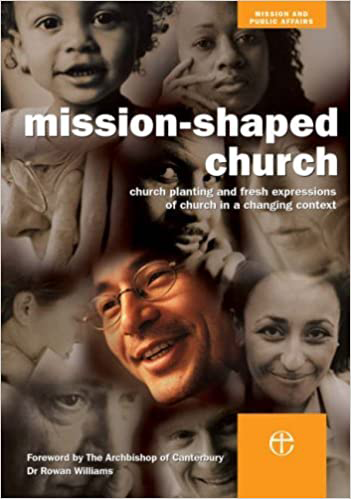The COVID-19 pandemic has encouraged church leaders around the world to ask searching questions about church life. When we come out of the crisis and enter perhaps a ‘new normal’, should congregations rethink discipleship, mission, and church? If so, the experience of ‘fresh expressions’ offers a resource for this self-examination.

‘Fresh expressions of church’ have been springing up in Europe, North America, Australia, South Africa, and South Korea, with interest elsewhere in Africa and Asia. They are new Christian communities among people who are mostly outside the institutional church.
Stimulating examples
Wildwood United Methodist Church in Florida has cultivated over 14 of these communities in the past eight years. They include:
| Arts for Love | art enthusiasts who gather to pray, worship, and create art together |
| Blessing Bags | a group who worship and pray as they collect and distribute essential items for homeless people. |
| Connect | a church for children with fun activities, breakfast, Jesus stories, and worship, meeting in the Martin Luther King Jr. Community Center. |
| Faithfully Fit | health enthusiasts who meet in the park for prayer, devotions, and walking. |
| Paws of Praise | a church for dog lovers who gather in the local dog park for prayer, worship, Scripture, and play. |
| Shear Love at Soul Salon | a pop-up salon offering free haircuts, prayer, and a Bible reflection. |
| Tattoo Parlor Church | faith-based tattoos as seekers worship Jesus with Holy Communion. |
| Trap Stars for Jesus | former and current drug dealers learn how to start legitimate businesses, with prayer and Scripture mixed in. |
| Skate. Pray. Repeat. | a group of friends who gather at indoor rinks and outdoor tracks to skate, pray, and share their faith. |
Small teams of Christians love and serve people outside the church and form community with each of these groups. Individuals are sensitively pointed toward Jesus as part of a fuller life. As they journey to faith, they evolve into worshipping communities where they are, yet part of the wider body of Christ.
Its beginning and growth

The language of ‘fresh expressions’ was introduced in 2004 by the Church of England’s seminal Mission-shaped Church Report,[1] which described new types of Christian community that were emerging and urged the Church to support them. The Report became one of the most influential in the Church of England’s recent history. Evangelicals have been at the forefront of these new communities, but interest has spread more widely, including within the World Council of Churches.
The Church of England aspires to plant an average of one ‘fresh expression of church’ per parish by 2030. The United Methodist Church of Florida aims to plant 500 in five years. The Protestant Church of the Netherlands (PKN) currently has over 100 teams pioneering ‘fresh expressions’.
Theological foundations
‘Fresh expressions of church’ are defined by four theological values:
![]() Missional. They participate in the mission of God to reach the world, especially those outside the church.
Missional. They participate in the mission of God to reach the world, especially those outside the church.
![]() Contextual. Just as the Son of God, in Jesus, immersed himself in the culture of first-century Palestine, they dwell in the cultures of the people they serve, demonstrating practical love, sharing the gospel, and forming new contextualized communities of faith.
Contextual. Just as the Son of God, in Jesus, immersed himself in the culture of first-century Palestine, they dwell in the cultures of the people they serve, demonstrating practical love, sharing the gospel, and forming new contextualized communities of faith.
![]() Transformational. In obedience to the Great Commission, through the Spirit they seek to transform people into Christ-likeness.
Transformational. In obedience to the Great Commission, through the Spirit they seek to transform people into Christ-likeness.
![]() Ecclesial. They are not stepping stones to an existing congregation. Rather, they start new worshipping communities where people already are, in the midst of their everyday lives. They affirm the theological importance of the church by bringing the church into the heart of daily existence.
Ecclesial. They are not stepping stones to an existing congregation. Rather, they start new worshipping communities where people already are, in the midst of their everyday lives. They affirm the theological importance of the church by bringing the church into the heart of daily existence.
A missionary method
The diagram below, known as ‘The Loving-First Cycle’ describes how most ‘fresh expressions’ emerge.

For example, Sue got to know fellow parents at the school gate. As she listened to them, she discovered that many would like to spend more time together.
So, as an expression of love, she arranged for them to meet on Thursday mornings in the school staff room. She provided coffee, fruit juice, and croissants. The parents watched a video about life issues from a gentle Christian perspective and shared their reactions.
In time, Sue noticed that some of them were becoming interested in Christ. So she shared Jesus by starting a Tuesday morning exploratory Bible study. The Thursday meeting continued.
Gradually members of the Tuesday group learnt to pray and began simple worship.
They became enthusiastic as church took shape among them but sad that their partners and friends at work and their children at school were not involved.
So they repeated the cycle by starting a gathering for them on Saturday afternoons with all-age activities, food, and some Christian input.
Of course, life is more messy than a diagram! So the circles may overlap, pile on top of each other, happen in a different order, and sometimes teams revisit an earlier stage.
Even so, a growing number of teams are using ‘The Loving-First Cycle’ as a map to plan their journey, recognizing how far they have travelled, and deciding where to go next.
Integrated mission
Each circle displays an aspect of God’s kingdom.
Listen
respects the other, a kingdom value.
Love
respects the other, a kingdom value.
Community
is integral to the kingdom.
Sharing Jesus
involves conversations about the person who announced God’s reign.
Church
and the kingdom will become one when Jesus returns.
Repeat
witnesses to the expansive nature of the kingdom, which is like a seed that grows into a vast tree (Matt. 13:31-32).
Thus one circle is not a mere stepping stone to another. Each circle has kingdom value in itself and continues as further circles are added.
Furthermore, the Great Commandment (to love others) and the Great Commission (to share the gospel) are brought together in a single, integrated form of mission.
‘The Loving-First Cycle’ resonates with the five marks of mission, used in some circles:
Tell
others about Jesus.
Teach
and baptize them in the faith.
Tend
to people’s pastoral needs.
Transform
the unjust structures of society.
Treasure
the natural world.
The cycle includes and extends these. More importantly, it joins them into a process. Instead of listing the ingredients of integrated mission, it offers a path for getting there. Marks are replaced by steps.
Here, then, is one of the contributions of ‘fresh expressions’. Rather than the different dimensions of mission flourishing after a new congregation has been started, they are present throughout the congregation’s birth.
Mission everywhere
Though there is still much to learn, for the global church the significance of ‘fresh expressions’ is that they can support mission in almost any context.[2]
- Mission at work? New Christian communities have emerged among office workers, patients of a medical practice, and (where it is allowed) in schools.
- Mission among people experiencing homelessness? Women who have been abused? Asylum seekers? Teenagers on drugs? People with learning difficulties? A small team can pay attention to them, love them, build community with them, introduce those interested to Jesus, encourage a safe and affirming Christian community to emerge, and bring this community as a gift to the wider church.
- Missional action for the environment or social justice? Christians can listen to people outside the church who share their concern, find ways to work together, form community as they do so, and explore how Christian spirituality can add colour to their shared involvement.
- Mission to the whole of life? Sport? Dog walking? Singing? Repairing bikes? ‘Fresh expressions’ are connecting with these and other interests.
- Mission in a village? Small town? In a neighborhood with multiple-deprivation? Or within an ethnic minority? New Christian gatherings are giving these settings their voices.
- Mission through conventional church planting? ‘Fresh expressions’ play a role here, too. When the new church is established, members can ask, ‘Whom are we not reaching?’ and start ‘fresh expressions’ among them. For people with mental or physical disabilities, or sex workers, or taxi drivers, or migrants from the same country, a small community dedicated to them may be just what they need. Later, leaders can draw a team from these communities to start another church in a different area.
‘Fresh expressions’ reveal Christ anywhere, with anyone.
‘Fresh expressions’ reveal Christ anywhere, with anyone. Ephesians 1:23 promises that when Christ returns, he will fill—or complete—all things. When Christians, as the body of Christ, start new Christian communities in the multiple settings of life, they foreshadow this future. They demonstrate that there is no sphere where Christ and his church cannot make their home.
A young adult in Pittsburgh, Pennsylvania described how he had been raised in a Christian family. In his late teens he drifted away from the church. He loved computer games. In one game he had to gain weight to cross a bridge. A message told him that he could get across the bridge for free if he watched a video. The video was all about grace.
The young man watched it and was then invited to an online Bible study group, which he attended. Later, he reconnected with the church off-line. Christ can be present in communal form in every section of life, even a computer game!
Both/and
In most cases, ‘fresh expressions’ can be understood as communities or congregations of an existing church.
In most cases, ‘fresh expressions’ can be understood as communities or congregations of an existing church. They are not better than traditional congregations. They complement them.
Older congregations connect with people on the fringes of the church. They safeguard and pass on the tradition. ‘Fresh expressions’ articulate the tradition in innovative ways for unreached contexts. Both can flourish alongside each other in mutual love and support.
As work continues to understand the theological implications of these new communities, might we gratefully anticipate a ‘mixed economy’ of traditional congregations, revitalized congregations with new and creative forms of worship, traditional church planting, and fresh expressions?[3]
Endnotes
- Graham Cray, ed., Mission-Shaped Church (London: Church House Publishing, 2004).
- Editor’s Note: See article by Allen Yeh, entitled, ‘The Future of Mission is from Everyone to Everywhere’ in January 2018 issue of Lausanne Global Analysis, https://lausanne.org/content/lga/2018-01/future-mission-everyone-everywhere
- Fresh expressions have been criticized theologically by Andrew Davison and Alison Milbank, For the Parish: A Critique of Fresh Expressions (London: SCM, 2010); John M. Hull, Mission-Shaped Church: A Theological Response (London: SCM, 2006); John Milbank, ‘Stale Expressions: The Management-Shaped Church’, Studies in Christian Ethics 21:1 (2008), 117-28; Martyn Percy, ‘Old Tricks for New Dogs? A Critique of Fresh Expressions’ in Evaluating Fresh Expressions: Explorations in Emerging Church, ed. Louise Nelstrop and Martyn Percy (Norwich: Canterbury, 2008), 27-39. For a response see Michael Moynagh, Church for Every Context: An Introduction to Theology and Practice (London: SCM, 2012); Fresh Expressions in the Mission of the Church: Report of an Anglican-Methodist Working Party (London: Church House Publishing, 2012).

